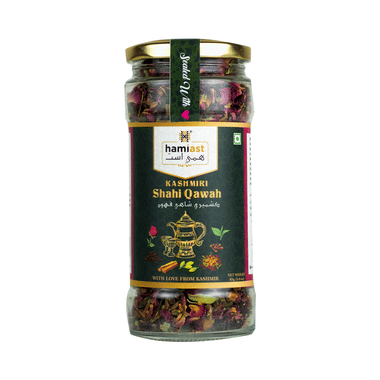Rs. 389
Not Available

Product Details
Hamiast Kashmiri Shahi Qawah (Kahwa)
Hamiast Kashmiri Shahi Qawah (Kawah) Though there is no documentary evidence about the birth of Qawah, It is said to have come from the Spice route during Kushan’s Empire. Many also believe that Qawah tea leaves originated from Yarkand Valley, currently in China. In Kashmiri, Kahwah means "sweetened tea". It seems to be related to the Turkish word for coffee, “Kahveh” or might be derived from the Arabic word “Qahwah" Historically, kahwah has been popular as a drink throughout Kashmir, Middle East, Iran, Central Asia and Afghanistan. In fact, Qawah never lost its popularity in these regions and now is a drink of choice worldwide. Nowadays in Kashmir, this historically popular drink is usually served to the guests after a celebration dinner.
Key Ingredients:
Qawah Tea (Green Tea),Kashmiri Saffron,Kashmiri Rose Petals,Cardamom,Cinnamon,Cloves,Black Pepper
Key Benefits:
Directions For Use:
Safety Information:
Hamiast Kashmiri Shahi Qawah (Kawah) Though there is no documentary evidence about the birth of Qawah, It is said to have come from the Spice route during Kushan’s Empire. Many also believe that Qawah tea leaves originated from Yarkand Valley, currently in China. In Kashmiri, Kahwah means "sweetened tea". It seems to be related to the Turkish word for coffee, “Kahveh” or might be derived from the Arabic word “Qahwah" Historically, kahwah has been popular as a drink throughout Kashmir, Middle East, Iran, Central Asia and Afghanistan. In fact, Qawah never lost its popularity in these regions and now is a drink of choice worldwide. Nowadays in Kashmir, this historically popular drink is usually served to the guests after a celebration dinner.
Key Ingredients:
Qawah Tea (Green Tea),Kashmiri Saffron,Kashmiri Rose Petals,Cardamom,Cinnamon,Cloves,Black Pepper
Key Benefits:
- Qawah works best in winters. A cup of Qawah can make you feel warm.
- Qawah works as a natural detox and improves body metabolism.
- In Kashmir, Qawah is usually served after meals as it may support digestion and assist metabolic processes.
- The Ingredients present in Shahi Qawah are high in antioxidants, vitamin C and Vitamin B12 etc which help to recharge the defence system of your body.
- Qawah helps to detoxify your body. The presence of antioxidants keeps your skin healthy.
Directions For Use:
- Boil 1 teaspoon of Kashmiri Shahi Qawah in 180 ml of water for 2-3 minutes
- Turn off the flame and let it infuse for a minute
- You may also add 2 sliced almonds to the tea cup
- Strain and pour. Sweeten with Honey and enjoy
Safety Information:
- Keep out of reach of children
- Read the label carefully before use
- Store in a cool and dry place












